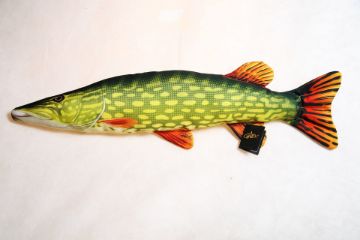Cookies help us deliver our services. By using our services, you agree to our use of cookies.
(0)
You have no items in your shopping cart.
Search
Shopping cart (0)
Products tagged with 'pillows'
Gaby Pillows Koi Carp Regular
GP175181
Nishiki-Goi 60cm Koi Carp ((錦鯉 nishikigoi ) are a domesticated and genetically selected form of the Common Carp (Cyprinus Carpio). Hailing from Japan, koi were first bred in the 1820’s in the town of Ojiya. Koi carp sport characteristic coloration that make them a popular pond and decorative fish. There are more than 120 different types of Koi worldwide, varying in color and shape. Of these, the most popular varieties are the Tancho, Shusui, Asagi, Sanke and Utsuri.
£21.99
Gaby Pillows Mackerel Regular
GP175174
Scomber Scombrus 60cm The Atlantic Mackerel (Scomber scombrus) is a pelagic fish of the mackerel family. It inhabits most coastal waters along the northern United States, the European Atlantic coast, the Meditterranean and Black Seas as well as the north-west Baltic. Adult specimens can reach some 50cm in length and weigh up to 1 kg. Mackerel are nomadic fish and live in large schools. They feed mainly on small crustaceans, plankton, snails and small fish. Aside from being a popular gamefish, the Atlantic Mackerel is an important economic driver of many national fishing industries, thanks to its high yield and long history of commercialization. It is prized for its taste and high concentrations of Omega-3 fatty acids and vitamin B12.
£20.99
Gaby Pillows Catfish Giant
GP175167
Silurus Glanis 115cm/200cm A member of the catfish family, the Wels is the largest freshwater predatory fish in Europe. It’s prime habitat are warm, slow- flowing waters in central, southern and eastern Europe and is present in brackish waters of the basins of the Baltic, Caspian and Black Seas. A true giant, it can reach more than two meters in length and can weigh more than 100kg. The Wels is a mostly nocturnal fish, feeding primarily on fish and other live prey. The species has a specific body shape, smooth skin and long “whiskers” or barbels which are used to locate food. It is a popular gamefish, renowned for its cunning and strength.
£33.99
Gaby Pillows Flounder Regular
GP175099
Platichthys Flesus 41cm Flounder are a group of flatfish species (Pleuronectidae). Representatives of this family of fish in the Baltic Sea include, among others, the Plaice, Flounder and Dab. They are a demersal fish, giving them their characteristic flat body shape and one-sided appearance. This fish can mask itself on the sea floor perfectly – thanks to the ability to change coloration and dig itself into the sand. Flounder are nocturnal predators, feeding mainly on small sea organisms during the night while resting buried in the sand during the day. The Flounder is invariably associated with the waters of the Baltic Sea, where they constitute a very important part of fisheries management and are part of the region’s culture and history.
£13.99
Gaby Pillows Cod Regular
GP175075
Gadus Morhua 38cm/75cm The Atlantic Cod (Gadus Morhua) is a predatory saltwater fish present in the Northern Atlantic Ocean as well as the seas of northern Europe, including the Baltic. It is a schooling fish which lives in deep water. Cod and members of their family feed mainly on small marine organism, especially small fish. It features a characteristics color pattern along its side. Cod is an important economic part of the fisheries of northern Europe, though continued pressure on its populations has seen stocks dwindle in the past decades. It, nonetheless, remains a highly prized fish by anglers.
£22.50
Gaby Pillows Perch Regular
GP175051
Perca Fluviatilis 50cm The Common Perch is a popular species of the genus Perca (the perches). It inhabits most Europe waters and is present in parts of Asia. It has also been successfully introduced into Australian reservoirs. The Perch distinguishes itself by its beautiful coloring of characteristic dark veritcal stripes on the body, bright red fins and dorsal fin with spines. Juvenile perches feed mainly on plankton, invertebrates and fish roe while older specimens become typical predators, often hunting in packs for small fish. It is a very highly sought after fish by anglers and puts up quite a fight.
£21.99
Gaby Pillows Pike Regular
GP175037
Esox Lucius 80cm The Northern Pike is a species of carnivorous fish of the genus Esox (the pike family, along with musky and North American pickerel). It inhabits almost every freshwater in the world and some coastal areas of seas. It exhibits the typical features of an ambush predator; a long body shape and camouflage colouring. The Pike feeds mainly on fish and small aquatic animals and birds. It is very sporting and highly sought after fish knows for its extravagant lunges and jumps. It is, nonetheless, a very sensitive species and reacts negatively to changes in the environment.
£23.50
Gaby Pillows Pike Giant
GP175006
The Giant Pike Esox Lucius 115cm/200cm The Northern Pike is a species of carnivorous fish of the genus Esox (the pike family, along with musky and North American pickerel). It inhabits almost every freshwater in the world and some coastal areas of seas. It exhibits the typical features of an ambush predator; a long body shape and camouflage colouring. The Pike feeds mainly on fish and small aquatic animals and birds. It is very sporting and highly sought after fish knows for its extravagant lunges and jumps. It is, nonetheless, a very sensitive species and reacts negatively to changes in the environment.
£32.75








